03/09/2025, By Iris Egea Quijada, Shabnam Khezri, Anton Neronov & Fatıma Silpagar
Introduction
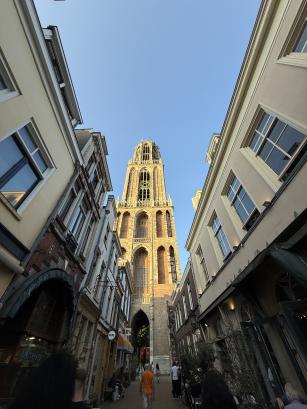
Utrecht, home to the largest university in the Netherlands, recently hosted the 2nd International Migration and Societal Change Conference which spanned two days, from June 19th to 20th ,2025. With our AIMs Lab colleagues, we attended the conference and took part in the exchange of ideas, research, and reflections on the evolving role of migration in shaping societies.
Keynotes
PLAYING WITH CATEGORIES AS A REFLEXIVE METHOD by Valentina Mazzucato
Mazzucato possibly gave the most resonating keynote speech of the conference with a very provocative call for migration studies, the need to expand migrant categories to better address migrant experiences. While migration scholars actively criticise mainstream migrant categories, not many suggestions for change have been developed. As researchers, we hold responsibility for the terms and categories we use in our research, as analytical categories often inform policy and can potentially reproduce certain policy interests. The use of certain categories can simplify migration processes and homogenise diverse migrant experiences against a model group. With this, many voices are silent. Strongly influenced by methodological nationalism, the categories that are mostly used are straight-jacketed concepts that often reproduce borders, establish irrational comparison and often miss the chance to analyse broad experiences and highlight sameness across different subjects. Mazzucato proposed to “play” with categories based on mobility. With her study on mobility trajectories of young lives and the effects of “home” visits for young people living in Europe, she proved her point. To look at mobility as an embodied experience makes us uncover the similarities between adolescents across the board. Indeed, she highlighted that closely comparing very mobile Dutch-origin and foreign-origin children's experiences can potentially open up new samples that uncover at ‘within group differences.’ This can potentially bring progressive change to policies that continue to restrict and look down on visits to the country of origin of many migrant-origin Dutch children. She also put forward the use of ethnographic methodologies to better release the benefits of studying mobility as a new category for migration studies.
Panel Sessions: Diverse Themes and Debates
Iris presented her work-in-progress on racial hierarchies of belonging at Panel 18 Migration and Belonging. The panel counted with fascinating presentations on the sense of belonging and integration paradox behind migrants’ trajectories in Australia, Chinese immigrants’ identities in Glasgow, women’s agency and negotiation of gender roles at a mosque and the impact of diasporic narratives in the midst of war and conflict. This was a very interesting panel, especially for the qualitative methodologies that the different studies included, with the important component of ethnographic research and participant observation. Overall, the presentations uncovered the rather unexplored migrant agency in migration and social studies.
Panel 36 on Migration and Professional Skills further developed these themes by focusing on the labour market trajectories of highly skilled migrants across Europe. Chaired by Jos Philips, the session brought together insightful presentations on transnational mobility, gig economy, credential recognition, and gendered constraints in professional integration. Fatima (89.51 KB) "File", together with colleagues from the Vrije Universiteit Brussel, shared early findings from a mixed-methods study on gendered responses to professional challenges in Belgium. Drawing on focus groups and survey data, the research highlighted how migrants entering via family reunification, often holding advanced degrees, are rendered invisible in labour policy due to labels like “dependent.” The presentation showed how gender roles further compound this invisibility, with women more often navigating underemployment or career shifts driven by caregiving responsibilities, while men face expectations tied to financial provision and identity. Together with the presentations, the discussions that followed made clear that migrant precarity is not incidental but structurally produced through the very design of labour and migration governance.
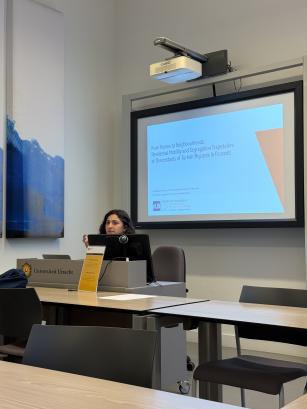
Panel 34 on Migration, neighbourhoods, and cities, explored how migration and urban change are mutually constituted through the spaces people inhabit, the social networks they sustain, and the transformations of the city itself. Shabnam presented her research on the residential trajectories of adolescents from a Turkish background in Brussels, following their residential (im)mobility from adolescence into adulthood. Drawing on linked geocoded census data from 2001 to 2015, the study used sequence analysis to distinguish four long-term trajectory types, showing how gender, migration timing, and family backgrounds shape (im)mobilities within the city’s fragmented urban landscape. Patterns of (im)mobility were not random but deeply path-dependent: early neighbourhood contexts tended to lock individuals into similar environments over time, with only a minority making moves towards more diverse or less ethnically concentrated areas, potentially in response to socio-economic opportunities or life-course events. Across all three contributions, the panel unpacked how migration becomes embedded in the material and symbolic geographies of cities, whether through residential settlement patterns, the use and meaning of public spaces, or the transformation of local urban economies, revealing the intertwined dynamics of inclusion, exclusion, and belonging in urban life.
We also attended the panel “Migration and Precarity: Navigating Risk and Resilience,” which explored how migrants navigate instability and exclusion in a range of national contexts. The presentations focused on diverse cases: strategies of survival among Syrian migrants in Russia and Germany, the everyday resilience of Filipino workers in New Zealand, the lasting consequences of the Toeslagenaffaire for migrant families in the Netherlands, and the use of audio-visual tools by illiterate migrants to access information. Across these examples, the panel highlighted the agency and adaptability of migrants in the face of structural constraints. At the same time, it raised important questions about how current policies often fail to reflect the complexity of migrant experiences. Rather than viewing migrants as passive subjects, the panel called for policy frameworks that recognise their everyday strategies and respond more directly to the realities they confront.
Migrant Tour of Utrecht
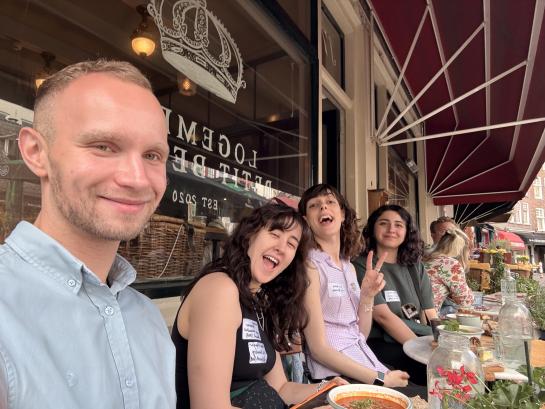
Nearly 4 in 10 residents of Utrecht are of migrant background. There is no doubt that Utrecht has been shaped by diversity. This is precisely what Utrecht University wanted to prove with the organisation of the migrant tour as a side activity of the conference.
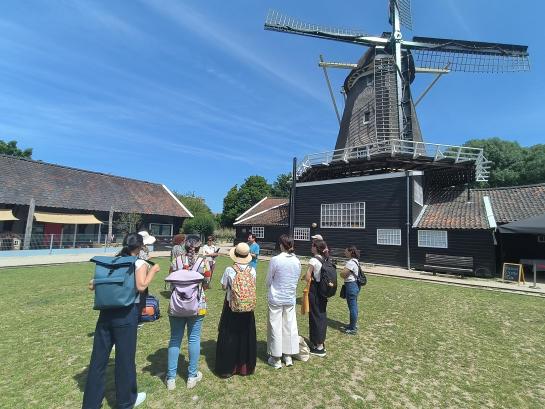
The tour started after midday on Thursday 20th, and it was organised by a sustainable tourism initiative that is active throughout the Netherlands, Migrantour. Being one of the hottest and sunniest days that the Dutch summer could ever gift someone with, we definitely needed the sunscreen and cap on. Our intercultural companion Çağlar, from Turkish origin, deliberately met us in front of the Molen de Ster, a windmill, possibly considered the ultimate symbol of Dutchness worldwide. Through a very inviting introduction that traced windmills’ origins back to Persia 500–900 AD, Çağlar managed to question and deconstruct the idea of Dutchness. This set the tone for a very participatory and engaging tour that showed a Utrecht different from the mainstream tourist guides, away from its massified quirky streets and Dutch canals overcrowded by tourists taking selfies. The tour took place in the Lombok neighbourhood, a migrant, vibrant and very industrial side of town that is often missed by most visitors.
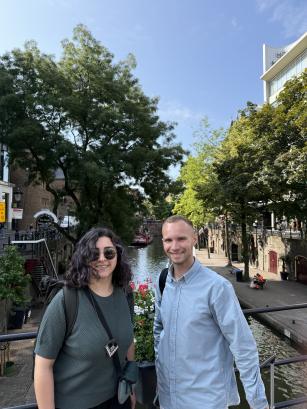
During this tour, we learnt about the history and the present legacies of the informal government school categories into “white”, “mixed” and “black” schools in the Netherlands. These differentiations were and still are a source of social divisions, segregations and stigma that influence children’s psychosocial development and prospects for life. We also learnt about the colonial legacies behind nutmeg and different colonial stores in the neighbourhood. The tour finalised in the lively Kanaalstraat, Canal Street. Again, misled by the Dutch connotations behind its name, this street is the most diverse in town. It is considered a home, a familiar space for our tour guide and many other Turkish-origin Utrechters. It was once politically celebrated for its diversity, and now it is the target of many police checks and sensationalist news headlines. However, it is just a street that is home to Arabic and Middle Eastern food and fashion stores. For our guide and many, this street feels like a time capsule where the sense of temporality is very much present in the daily trajectories of many. The tour finalised at the headquarters of the Migrantour team with very good feedback from all participants as indeed Çağlar had succeeded in showing Utrecht from the eyes of a migrant. When you visit a few Dutch cities, they all follow the same theme, they all become the same. Thanks to this tour, we uncovered Utrecht’s distinctiveness. Its uniqueness, recalled through the life experiences of a migrant, will now remain in our memories for a long time.
Conclusion
Utrecht was the perfect place for this kind of conference. With its canals, cosy cafés, and walkable streets, the city made it easy to slow down, reflect, and connect with others. Utrecht University, with its long history and strong focus on migration and social research, offered just the right environment for thoughtful conversations and new ideas to take shape. Because the conference was small, it felt welcoming and easy to navigate. There was plenty of time to talk, ask questions, share feedback, and meet people in between sessions without feeling rushed. It was the kind of setting that reminded many of us why in-person conferences still matter.
